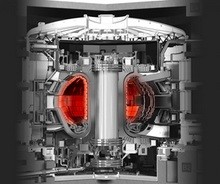DTT - Divertor Tokamak Test facility
DTT - Divertor Tokamak Test facility / DTT - Impianto di prova Divertor Tokamak
Segnalato dal Dott. Giuseppe Cotellessa / Reported by Dr. Joseph Cotellessa

One of the main challenges in the Fusion roadmap
is to develop a heat and power exhaust system able
to withstand the large loads expected in the
divertor of a fusion power plant. EUROfusion has
launched a relevant project to investigate
alternative power exhaust solutions, the design of a
new machine named "Divertor Tokamak Test
facility" (DTT), capable of integrating all the
relevant physics and technology issues.
DTT should operate in integrated scenarios, with
significant power loads, flexible divertors, plasma
edge and bulk conditions approaching as much as
possible those planned for DEMO. A trade-off
between these requirements and the need to realize
the new experiment accomplishing the DEMO
timescale, leads to the choice of the following
machine parameters: major radius R=2.15 m,
aspect ratio A=3.1 (A=R/a, where ‘a’ is the
tokamak minor radius), toroidal field BT=6 T,
plasma current Ip=6 MA, additional power
PTot=45 MW. The machine will have the
possibility to test several different magnetic
divertor topologies. Different plasma facing
materials will be tested (tungsten, liquid metals) up
to a power flow of the order of 20MW/m2. The
related studies and experiments will allow a
valuable development of innovative technologies
in several different fields, with relevant spin off for
the industries of all European Countries.
According to the European Road Map, the DTT
experiment should start its operation in 2022. To be
coherent with this plan, the realization of the
device will cover a time of around 7 years, starting
from the first tender (during 2016) up to full
commissioning and the first plasma.
The occupational impact is expected to be
significant, with at least 150 people involved for
the operation. A significant amount of on-site
workers are expected during the construction, not
to mention the indirect and spin-off opportunities.
The expected economic impact on the hosting
territory is also significant (e.g. the realization of
buildings, electrical grid, maintenance, etc.). The
continuous presence of an international scientific
staff will cause a spin-off linked to the guest family
life and activities.
Whereas the European Programme allocated about
60 M€ in Horizon 2020, the expected total cost for
realizing this DTT proposal is estimated to be
about 500 M€. Recently, Italian government has
offered the opportunity to get complementary
funding for a dedicated exhaust facility located in
Italy. The proposal is among the projects submitted
to the 315 billion Euro of Juncker's plan (EFSI:
European Fund for Strategic Investments).
ITALIANO
Una delle principali sfide nella Road Map verso la
Fusione è costituita dal problema dei carichi
termici. A tal fine EUROfusion ha fatto partire un
programma per studiare soluzioni alternative al
problema dei carichi termici in DEMO, con il
progetto di una macchina denominata "Divertor
Tokamak Test facility" (DTT), in grado di fornire
soluzioni integrate con tutti gli aspetti fisici e
tecnologici.
DTT dovrà operare in scenari integrati, con carichi
termici rilevanti, divertori flessibili, condizioni di
plasma simili a quelle previste per DEMO. Il
compromesso tra prestazioni richieste e la
necessità di rispettare la scala dei tempi dettata
dalla Road Map ha portato alla scelta dei seguenti
parametri: raggio maggiore R=2.15 m, rapporto di
aspetto A=3.1 (A=R/a, dove ‘a’ è il raggio minore
del tokamak), campo magnetico toroidale BT=6 T,
corrente di plasma Ip=6 MA, potenza addizionale
PTot=45 MW. La macchina potrà provare
differenti concetti e topologie di divertore. Saranno
testati diversi materiali con flussi termici fino a
20MW/m2. Le attività di ricerca correlate
costituiranno una notevole spinta per lo sviluppo di
tecnologie innovative in vari settori, con rilevanti
ricadute per le industrie europee.
DTT sarà operativo nel 2022. Pertanto, la
realizzazione durerà circa 7 anni a partire dalla
prima gara (2016) fino alla messa in servizio. Le
operazioni ed il programma sperimentale
dovrebbero poi coprire un periodo di oltre venti
anni, fino all'inizio della costruzione di DEMO ed
oltre.
L’impatto occupazionale previsto è rilevante,
almeno 150 persone coinvolte nella
sperimentazione. E' inoltre previsto un notevole
numero di lavoratori coinvolti nelle fasi di
costruzione ed operazione, senza contare le
opportunità per spin-off e sub-appalti.
L'impatto economico previsto sul territorio è
significativo nelle fasi di costruzione ed in quelle
successive (edifici, rete elettrica, manutenzione,
ecc.). La presenza permanente di un gruppo
internazionale darà luogo a ricadute sul territorio
legate al soggiorno del personale e delle relative
famiglie.
EUROfusion ha stanziato circa 60 M€ in Horizon
2020, ma il costo previsto per la realizzazione di
DTT è valutato intorno alla cifra di 500 M€.
Vedendo nel progetto DTT un'occasione per dare
un contributo al problema energetico ed al tempo
stesso investire nella ricerca europea con
prospettiva di elevatissimo ritorno economico, il
governo italiano ha offerto l'opportunità di ottenere
i finanziamenti necessari a costruire DTT in Italia.
La proposta è fra i progetti presentati per il
finanziamento tramite i 315 miliardi di Euro
previsti dall'Agenda Juncker (EFSI: European
Fund for Strategic Investments).



Commenti
Posta un commento